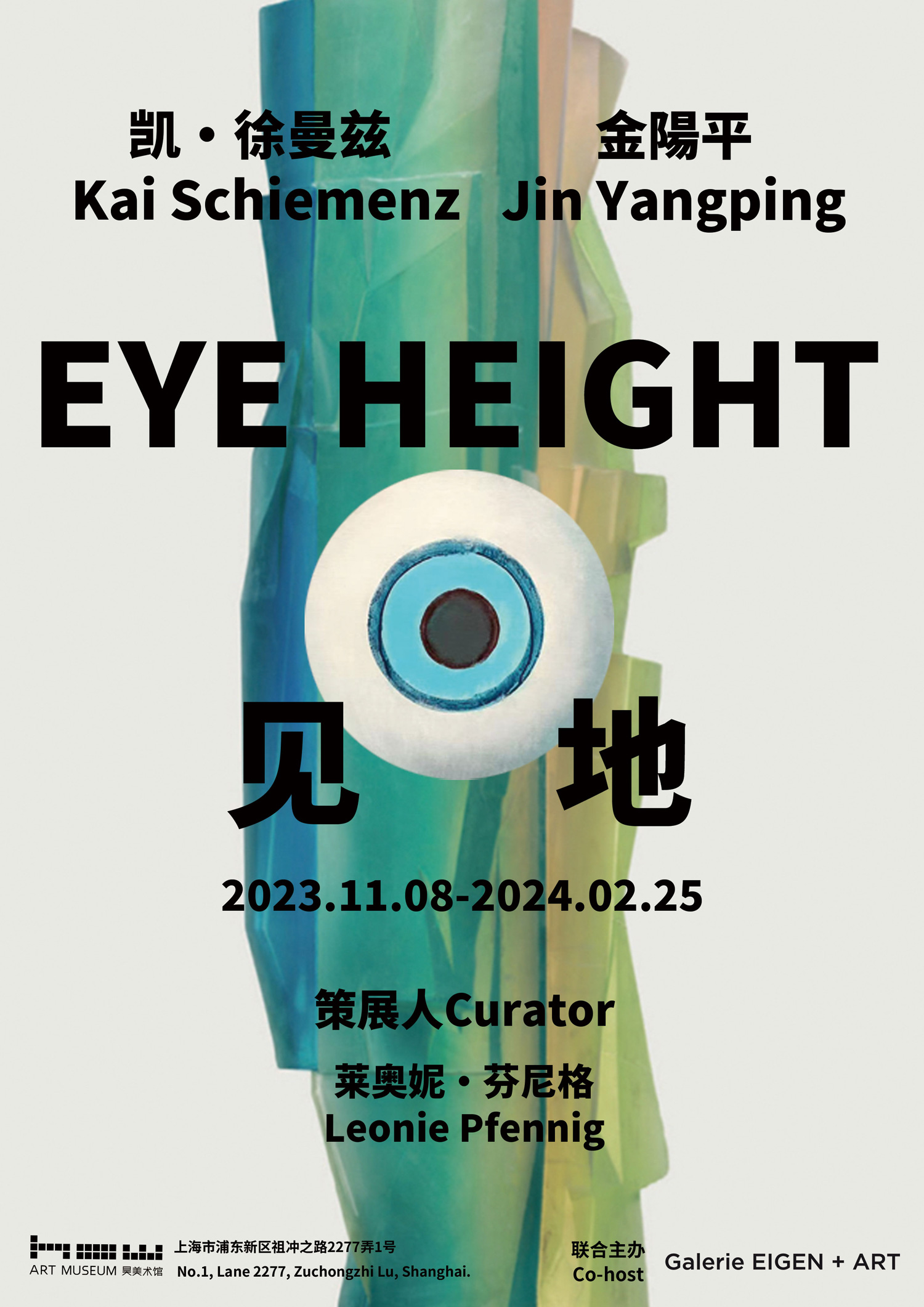展期 Period:
2023.11.8—2024.2.25
艺术家 Artist:
金阳平 Jin Yangping、凯·徐曼兹 Kai Schiemenz
策展人 Curator:
主办 Host:
联合主办 Co-host:
艾根画廊 Galerie EIGEN + ART
地点 Venue:
新闻稿 Press Release:
HOW昊美术馆很荣幸地宣布,在昊美术馆二楼展厅推出“见地:金陽平&凯·徐曼兹”展,展览将分别呈现中国艺术家金陽平和德国艺术家凯·徐曼兹的85组近期作品。
本次展览是继两位艺术家2019年之后的又一次合作,两位艺术家的作品在跨文化的语境下用不同的媒介与形式语言共同讨论时间、身体,以及环境等话题。展览题目“见地(Eye Height)”比喻眼睛看往的高度与方向,暗示所读所见的知识走向。
艺术家金陽平(1971年生)将他在展览“见地”中的作品分为了五个小组,赋予每件展品以其个人独特的叙事线索。首先是被称为“内部模型”的第一章节,在这个部分中,我们直面各种形态的模型,包含平面绘画以及立体的表现手法。最具有代表性的是名为“圆(circular)”的作品,这是一只看起来有些异常的眼球,由于缺少眼睑的部分,因此看起来并不那么圆;最后,在画布未涂色的空白部分有一个洞。当我们分别从整体和组成部分这两个不同的视角来观看这一组作品时,我们能从中看到什么? 这些画布揭示了什么,又有什么隐藏在其背后?
什么构成了雕塑作品?——是三维的空间特征?是可以通过走动来获得多个观察角度?还是构成、组装和铸造艺术品的材料?在凯·徐曼兹(1966 年生于德国埃尔福特)的雕塑作品中,有两个核心概念:呈现和过程。每件作品都曾是另外一种物体:岩石/石块或聚苯乙烯块通过硅胶模具制作成的彩色玻璃;电脑涂鸦最终被转化成了瓷砖;亦或者混凝土基座在新的环境中变成了独立的雕塑。除了两个核心概念之外,其中还包括建筑和城市空间的概念,这些抽象的物体都是从这些概念中产生的。
回到展览“见地”这个词的本身,它不仅在专业术语中将身体尺寸与视野范围联系起来,定义了一个人纯粹以身体能够看到什么;相反,这里的“见地”意味着彼此感知,相互记录与尊重。这里的这两层含义似乎是截然相反的,由于成年人客观的体型原因,从视觉上应当能够看的比孩子更远。但从实际上来说,无论是艺术训练的缺乏,还是对知识的好奇心的缺乏,当成年人对世界不予理会时,孩子通常能看到更多也更多样化的事物。这是一种由感知引导的视觉,由身体的控制来影响所见的事物,同时允许外界存在来影响自身,从而导致了人只有处在一种因果关系中才能真正地理解和感知。
金陽平在他的画作中巧妙地向我们展示了“看”的含义,“看”这个过程本身并不是真正可见的,但却是可触摸的,这就是为什么艺术史学家乔治·迪迪-胡伯曼(Georges Didi-Huberman)把“看”称为“盲目的”原因。那么,怎样才能把这一点用更具象的方式传递出来,而不是用“从后面看的脸”的方式来表达呢?我们只能凭借直觉来猜测这张脸可能是什么样子,但这不意味着我们应当互相注视彼此,而是意味着我们所观察到的并非总是那么清晰明了,因此求证和反复观察变得尤为重要。
在凯·徐曼兹的部分,他将各种不同的物体展示出来,让观众仿佛置身于公园景观中,可以在其中漫步。他摒弃了完全架空的基座,而使用了平面基座,并使其成为作品的一部分,与作品相得益彰。他的作品始终与人体及其高度保持着一种关系——参观者与艺术品处在同一水平视线上。
*摘自德国策展人莱奥妮·芬尼格和丽莎·舒茨为本次展览撰写的文章
HOW Art Museum is pleased to announce that the exhibition Eye Height: Jin Yangping& Kai Schiemenz will be on view at 2F Gallery at HOW Art Museum. The exhibition will present 85 sets of recent works by Chinese artist Jin Yangping and German artist Kai Schiemenz.
This exhibition is another collaboration between the two artists after 2019. Their works use different media and formal languages to discuss topics such as time, body, and environment in a cross-cultural context. The title of the exhibition "Eye Height" is a metaphor for the height and direction in which the eyes look, implying the direction of knowledge people read and seen.
Artist Jin Yangping (*1971) divided his works in the exhibition "Eye Height" into five distinct groups, imbuing each exhibit with its own unique narrative thread. First comes the chapter titled "Internal Models", where we confront various forms and models, encompassing both painted and sculpted techniques. The most representative is a series named "Circular", an unusually shaped eyeball, appearing less circular due to the absence of eyelids; and finally, a hole in an unpainted section of the curtain. When we view this series as a whole and in its individual components, what do we see? What do these curtains unveil, and what remains hidden behind them?
What constitutes a sculpture? Is it the three-dimensional spatial feature? Is it the condition of observe from multiple perspectives by walking? Or Is it the construction material, extraction material, model or casting material of the artwork? In the sculptures of Kai Schiemenz (b. 1966 in Erfurt, Germany) there are two core concepts: surface and process. Each piece was once another object: types of rock/stone or polystyrene blocks were made into stained glass through silicone molds; computer graffiti was eventually transformed into ceramic tiles; or perhaps the concrete base has become an independent sculpture in the new environment. In addition to those two core concepts, they also include the concepts of architecture and urban space, from which these abstract objects are derived.
Returning to the term "Eye Height" itself, it not only links bodily dimensions with visual scope in technical terminology, defining what a person can purely see with their body; rather, here "Eye Height" implies mutual perception, mutual recording, and mutual respect. These two layers of meaning seem fundamentally opposite. Due to objective bodily dimensions, adults should be able to see farther than children from a visual standpoint. Yet, in reality, whether due to a lack of discipline or a lack of curiosity for knowledge, children often see a more diverse range of things. This is a visual guided by perception, where control of the body affects what is seen, and similarly, allows the external world to influence the self, leading to an understanding of perception only in consequences.
Jin Yangping cleverly showcases the meaning of "seeing" in his artworks. This process is not truly visible but tangible, which is why art historian Georges Didi-Huberman calls "seeing" "blind". So, how can this be conveyed in a more concrete way, rather than expressing it as a "face seen from behind"? We can only intuitively guess what this face might look like, but that doesn't mean we should gaze at each other. It means that what we observe is not always so clear-cut, hence precision and repeated observation become particularly important.
In the part of Kai Schiemenz, he presents the diverse objects as if in a park landscape, through which gallery-goers can stroll. He renounces elevating pedestals either completely or in favor of flat plinths, which become part of the work and complement it. There is always a relationship with the human body and its dimensions – an eye-level on which visitor and work of art face one another.
*Excerpted from the article written by German curator Leonie Pfennig and Lisa Schütz

